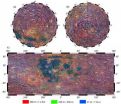(Press-News.org) Toronto, ON – Facebook is well-known for connecting friends, publicizing events and allowing people ample space to procrastinate online.
But recently, a scientist at the University of Toronto Scarborough (UTSC) helped illuminate a powerful new use for the social networking tool.
In January, UTSC PhD candidate Devin Bloom helped conduct the first ichthyological survey on Guyana's remote Cuyuni River. Led by Oregon State University's Dr. Brian Sidlauskas, the goal was to find out which species of fish live in the Cuyuni and get a good estimate of their abundance.
During the survey, Bloom and the rest of the research team spent two weeks catching as many fish as they could. They even slept in makeshift jungle camps. But after collecting more than 5,000 specimens, the team had a big problem.
In order to get the fish out of the country, the research team need needed an accurate count of each species and provide a detailed report to the Guyanese government. Since the team had to return to North America as soon as possible, they had just a few days to identify thousands of fish specimens.
That's when Bloom, who isn't exactly the most tech-savvy guy out there, suggested Facebook. Sidlauskas loved the idea, so he uploaded photos of each species. And in less than 24 hours, their network of friends—many of whom hold PhDs in ichthyology and are "diehard fish-heads"—had identified almost every specimen. With 5,000 identifications in hand, the team was able to deliver their results to the government and return home on schedule.
The team's novel use of Facebook to accurately crowdsource scientific data could change the way academics view social networking. It has certainly led Bloom to change his mind about the value of online tools. "Social networking is so powerful," he says, "and scientists should be using it more to connect with the world-at-large."
###
The Cuyuni River trip was funded through the Biological Diversity of the Guiana Shield program at the Smithsonian Institution's National Museum of Natural History.
Crowdsourcing science: Researcher uses Facebook to identify thousands of fish
2011-05-14
ELSE PRESS RELEASES FROM THIS DATE:
Gainesville, Georgia, Spa Wins LNE & Spa Award for Most Outstanding Green/Wellness Spa in 2011
2011-05-14
On April 3, 2011, The Spa on Green Street received a distinguished honor when they were announced as the grand winner of the new Les Nouvelles Esthetiques & Spa Award. Recognized for their excellence in the green/wellness category, The Spa on Green Street emphasizes the importance of preventative care, lifestyle changes, ongoing fitness programs, and environmental responsibility.
Dedicated to the sustained health of their guests and the environment through education and individualized and group programs, The Spa on Green Street is committed to finding ways to improve ...
2 defective proteins conspire to impair the nerve cell's 'powerhouse' in Alzheimer's disease
2011-05-14
Two proteins that are abnormally modified in the brains of patients with Alzheimer disease collude, resulting in ill effects on the crucial energy centers of brain cells, according to new findings published online in Neurobiology of Aging.
The research raises the possibility that pathological forms of two proteins, amyloid beta and tau, which make up the pathological hallmarks of the brains of Alzheimer patients – plaques and tangles – may work in tandem to decrease the survival of brain cells.
The findings come as part of a bundle of results from several laboratories ...
MIT research: Toward faster transistors
2011-05-14
CAMBRIDGE, Mass. -- In the 1980s and '90s, competition in the computer industry was all about "clock speed" — how many megahertz, and ultimately gigahertz, a chip could boast. But clock speeds stalled out almost 10 years ago: Chips that run faster also run hotter, and with existing technology, there seems to be no way to increase clock speed without causing chips to overheat.
In this week's issue of the journal Science, MIT researchers and their colleagues at the University of Augsburg in Germany report the discovery of a new physical phenomenon that could yield transistors ...
The ties that bind: Grandparents and their grandchildren
2011-05-14
Close your eyes for a moment, open your treasure trove of memories and take a step back in time to your childhood. Do you remember your grandfather gently scooping you up into his warm and comforting embrace? Or sitting by your grandmother's side as she lovingly baked pies chock full of delicious, juicy warm apples sprinkled with crumbly cinnamon bits?
The bond between grandparents and their grandchildren seems to be a magical one, and now, a new article published in the April issue of Current Directions in Psychological Science, a journal of the Association for Psychological ...
Scientists design new anti-flu virus proteins using computational methods
2011-05-14
A research article May 12 in Science demonstrates the use of computational methods to design new antiviral proteins not found in nature, but capable of targeting specific surfaces of flu virus molecules.
One goal of such protein design would be to block molecular mechanisms involved in cell invasion and virus reproduction.
Computationally designed, surface targeting, antiviral proteins might also have diagnostic and therapeutic potential in identifying and fighting viral infections.
The lead authors of the study are Sarel J. Fleishman and Timothy Whitehead of ...
I know you, bad guy!
2011-05-14
Most people who have had the experience of having pet animals in their houses have the gut feeling that the animals can "recognize" us. They seem to recognize our faces, our voices and our smell. One way or another, they respond to us differently from other people.
Actually, this is not just a gut feeling. Numerous studies have shown that domesticated animals, such as honey bees, chickens, pigeons, sheep, dogs, llamas, penguins, seals, rabbits, horses, lizards and octopuses, can recognize humans individually. The common thing among these animals is that they are exposed ...
Moon's rough 'wrinkles' reveal clues to its past
2011-05-14
Written on the moon's weary face are the damages it has endured for the past 4-1/2 billion years. From impact craters to the dark plains of maria left behind by volcanic eruptions, the scars are all that remain to tell the tale of what happened to the moon. But they only hint at the processes that once acted—and act today—to shape the surface.
To get more insight into those processes, Meg Rosenburg and her colleagues at the California Institute of Technology, Pasadena, Calif. put together the first comprehensive set of maps revealing the slopes and roughness of the moon's ...
Satellite images display extreme Mississippi River flooding from space
2011-05-14
Recent Landsat satellite data captured by the USGS and NASA on May 10 shows the major flooding of the Mississippi River around Memphis, Tenn. and along the state borders of Tennessee, Kentucky, Missouri, and Arkansas as seen from 438 miles above the Earth.
The flood crest of 47.87 feet on May 10, is the second highest rise in recent history; the highest being 48.7 feet in 1937. Five counties surrounding Memphis have been declared disaster areas, and the costs of the flooding are expected to approach $1 billion. The Mississippi River crest continues to move south and ...
Imajin Books Releases 'Under a Texas Star', a Historical Western Romance by Alison Bruce
2011-05-14
Imajin Books is pleased to announce the release of Under a Texas Star, a historical western romance by Alison Bruce that is already receiving rave reviews. Midwest Book Review calls it, "A delightful Western tale that blends engaging adventure with spirited romance. Reminds me of Louis L'Amour novels." Award-winning author Phyllis Smallman says, "This is a rollicking adventure and Marly Landers is a girl with True Grit."
So what's Under a Texas Star about?
Disguised as a boy, Marly joins a handsome Texas Ranger in the hunt for a con man and they ...
Rochester autism researchers present new findings at IMFAR
2011-05-14
Much about autism is unknown, but researchers from the University of Rochester Medical Center (URMC) are working to learn more about the neurodevelopmental disorder and its most effective treatments. A team of researchers from URMC joins researchers from across the world in San Diego this week for the 10th annual International Meeting for Autism Research (IMFAR).
Rochester researchers are presenting six abstracts on topics ranging from complementary medicine-use rates to nutritional insufficiencies in children with autism spectrum disorders. They even looked at how artificial ...




